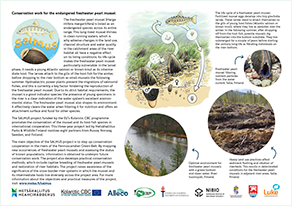Freshwater pearl mussel’s path over millions of years
Freshwater pearl mussel has lived as a species through millions of years and turbulent geological eras. Nevertheless, man’s actions have resulted in mussel’s prevailing status as an endangered species all over the world. The main reasons behind the decline of mussel populations are reproduction problems and adverse habitat changes due to harmful land-use practices. In addition, hydroelectric power plants and other river channel constructions prevent the migrations of salmonid fishes. This is currently a key factor hindering the reproduction of the freshwater pearl mussel which needs a young Atlantic salmon or brown trout as its intermediate host in the larval phase.
Freshwater pearl mussel is the longest-living animal species in Finland retaining its reproduction capacity even at the age of 200 years. This option gives hope for successful restoration actions in mussel’s poor-quality living environments.
This info material is produced in the ENI Kolarctic CBC project SALMUS. The project’s main goals were to investigate freshwater pearl mussel populations status and to develop new conservation methods among all four participating countries of the project. Fictional stories of this publication are written by a Finnish writer Anni Kytömäki.
